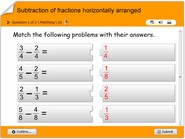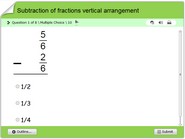Subtraction of fractions horizontally arranged quiz
How to do subtraction of fractions horizontally arranged quiz
In this interactive online math quiz children will learn how to subtract fractions. In subtracting fractions kids should watch out for denominators and numerators. There are a series of matching exercises in which kids have to solve each problem and select the correct answers. This quiz will work as a math test for children in 3rd, 4th, 5th and 6th grades. Cool math game for kids | math trivia questions | classroom and home testing resource on subtracting fractions.
Subtraction of fractions can be a tricky concept for children to grasp, but with the right approach and practice, it can be made easy to understand. The key to subtracting fractions is to have a common denominator, which is the bottom number of the fraction.
When subtracting fractions that have different denominators, we first need to find a common denominator. A common denominator is a number that is divisible by both denominators. For example, if we are subtracting 1/4 from 2/3, the common denominator would be 12 because both 4 and 12 are divisible by 4, and both 3 and 12 are divisible by 3. Once we have a common denominator, we can subtract the fractions by subtracting the numerators (the top number) while keeping the denominator the same. So in this example, 2/3 – 1/4 would be equivalent to (23)/(34) – (13)/(14) = 6/12 – 3/12 = 3/12.
Another way to visualize this is by using a horizontal fraction bar, where the numerator is on top and the denominator is on the bottom. Using the same example as before, we would have:
2/3 – 1/4 =
3 4 2 1
We find common denominator, in this case it is 12,
3 4 2 1
Now, we can easily subtract the numerators which is 2-1 = 1, hence the result is 1/12
When subtraction fractions that are arranged horizontally and both fractions have the same denominator, it is just as simple as subtracting the numerators. For example, 3/4 – 2/4 would be 1/4. In this case the denominator is already common and no conversion is needed.
It is also helpful to use visual aids such as drawing out a picture or using manipulatives like fraction circles or blocks to help children understand the concept of subtracting fractions.
Practice is important when learning how to subtract fractions, so be sure to provide plenty of examples for children to work through. Encourage them to check their work by reducing their answers to their lowest terms and make sure the denominator and numerator are not zero.
To sum up, subtraction of fractions is all about finding the common denominator and then subtracting the numerators. With a little bit of practice, children will be able to subtract fractions with ease!


